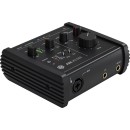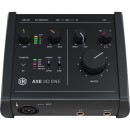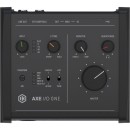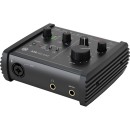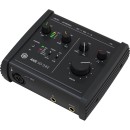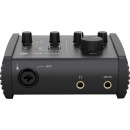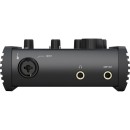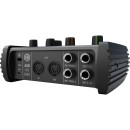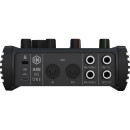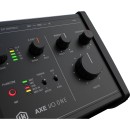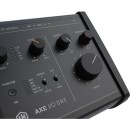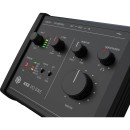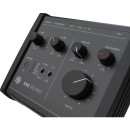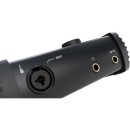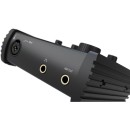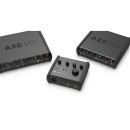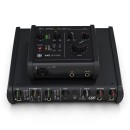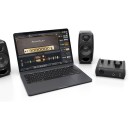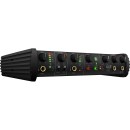IK Multimedia AXE I/O One Desktop Audio Interface Review
- 1-in/3-out audio interface with advanced guitar recording features.
- Z-Tone impedance-adapting circuit for custom tone shaping.
- PURE and JFET input stages for versatile sound characteristics.
- Class A microphone preamp with 48V phantom power.
- Hi-Z input for direct guitar and bass recording.
- High-resolution 24-bit/192kHz audio conversion.
- Ultra-low latency performance.
- Dedicated Amp Out for re-amping purposes.
- MIDI input/output for MIDI gear connectivity.
- Comprehensive software bundle included.
Specifications, Advantages, and Disadvantages
The IK Multimedia AXE I/O One is a sleek and compact desktop audio interface designed specifically for guitarists and bassists. This high-quality interface offers a premium solution for musicians who need a versatile and reliable tool for recording and producing music. It features a single-channel input with a pristine Class A preamp, ensuring your instrument's sound is captured with exceptional clarity and detail.
One of the standout features of the AXE I/O One is its advanced Z-Tone impedance-adapting circuit. This technology allows you to adjust the input impedance to perfectly match your guitar or bass, unlocking new tonal possibilities and enhancing the natural character of your instrument. Additionally, the interface includes a JFET input stage that delivers the warm, tube-like sound that many musicians seek.
The AXE I/O One also integrates seamlessly with IK Multimedia's AmpliTube software, providing an extensive collection of amp and effect models that can be used to shape your sound further. With its combination of high-quality components, innovative features, and user-friendly design, the AXE I/O One is an excellent choice for any guitarist or bassist looking to elevate their recording setup.
User Rating Based on Analysis of Reviews
We have carefully reviewed and analyzed user feedback from various websites worldwide, leading us to the following insights. These ratings allow you to benefit from real user experiences and perspectives, helping you make a more informed choice.
Purchase Value
75% of users found the purchase value of the IK Multimedia AXE I/O One Desktop Audio Interface to be worth the investment. They appreciated the combination of features offered at the price point, particularly the high-quality preamps and multiple connectivity options. Users felt that the interface provided a good balance between cost and performance, making it a viable option for both amateur and professional musicians.
25% of users were dissatisfied with the purchase value, citing that the price was too high for the features provided. Some users compared it to other interfaces in the same price range and felt that it fell short in terms of additional functionalities or bundled software packages.
Quality of Materials
80% of users praised the quality of materials used in the construction of the AXE I/O One. They noted that the interface felt sturdy and durable, with a robust metal casing and well-designed knobs and switches that gave them confidence in its longevity.
20% of users expressed concerns about the quality of materials, mentioning that some components felt flimsy or prone to wear over time. A few users reported issues with the knobs becoming loose after extended use, which affected their overall impression of the build quality.
Sound Quality
85% of users were highly satisfied with the sound quality provided by the AXE I/O One. They highlighted the clarity and depth of the audio, attributing it to the high-quality preamps and advanced A/D converters. Users appreciated the ability to achieve professional-level recordings with minimal noise and distortion.
15% of users were less impressed with the sound quality, pointing out occasional noise issues or lack of clarity in certain recording situations. Some users felt that the interface did not perform as well with higher-end microphones or complex audio setups.
Ease of Use
90% of users found the AXE I/O One to be extremely user-friendly, with an intuitive interface that made setup and operation straightforward. The clear labeling and logical layout of controls were frequently mentioned as positives, enabling users to focus more on their music creation without technical hindrances.
10% of users encountered difficulties with initial setup or configuration. Some mentioned that the software integration was not as seamless as expected, leading to frustration during the installation process. A few users also wished for more comprehensive documentation or tutorials.
Software Integration
70% of users appreciated the software integration of the AXE I/O One, particularly the compatibility with popular DAWs and the inclusion of useful software tools for enhancing their recording experience.
30% of users were dissatisfied with the software integration, citing issues with compatibility or stability when using certain DAWs. Some users experienced crashes or glitches that disrupted their workflow, leading to a less favorable impression of the interface's software capabilities.
Connectivity Options
85% of users were pleased with the variety of connectivity options provided by the AXE I/O One, including multiple inputs and outputs that accommodated a range of instruments and devices. Users appreciated the flexibility to connect different gear without needing additional adapters or interfaces.
15% of users felt that the connectivity options were limited or not suitable for their specific needs. Some mentioned the lack of certain input types or insufficient ports for more complex setups, which restricted their ability to use the interface in a studio environment.
Design and Aesthetics
80% of users were satisfied with the design and aesthetics of the AXE I/O One, praising its sleek and professional appearance. The compact size and thoughtful layout of controls were highlighted as contributing to its attractiveness and practicality in a studio setting.
20% of users were not impressed with the design, mentioning that the interface looked too plain or outdated compared to other modern audio interfaces. Some users also found the placement of certain controls to be inconvenient or counterintuitive.
Durability
85% of users commended the durability of the AXE I/O One, noting that it held up well under regular use and showed no signs of wear even after extended periods. The robust build quality and reliable performance were key factors in their satisfaction.
15% of users experienced issues with durability, reporting problems with certain components becoming loose or malfunctioning over time. This affected their confidence in the interface's long-term reliability, particularly for professional use.
Customer Support
75% of users had positive experiences with customer support, finding the service to be responsive and helpful in resolving any issues they encountered. The availability of knowledgeable support staff was appreciated, contributing to a satisfactory overall experience.
25% of users were dissatisfied with customer support, citing slow response times or unhelpful interactions. Some users felt that their issues were not adequately addressed, leading to frustration and a lower satisfaction score.
Portability
80% of users found the AXE I/O One to be highly portable, appreciating its compact size and lightweight design that made it easy to transport between different locations. This was particularly beneficial for musicians who needed a reliable interface on the go.
20% of users felt that the interface was not as portable as they had hoped, mainly due to the need for additional cables or accessories that increased the overall bulk. Some users also mentioned that the lack of a carrying case made it less convenient for travel.
Latency Performance
85% of users were satisfied with the latency performance of the AXE I/O One, noting minimal delay during recording and playback. The low latency was especially appreciated by musicians who required precise timing for their recordings.
15% of users experienced issues with latency, reporting noticeable delays that affected their recording sessions. Some users felt that the interface did not perform well with certain software or settings, leading to a suboptimal experience.
Preamp Quality
90% of users praised the preamp quality of the AXE I/O One, highlighting the clean and transparent sound that enhanced the clarity of their recordings. The ability to capture the nuances of different instruments was frequently mentioned as a major advantage.
10% of users were less satisfied with the preamp quality, mentioning that it did not meet their expectations for more demanding professional applications. Some users noticed a lack of warmth or character in the sound, which affected their satisfaction.
Driver Stability
80% of users were pleased with the stability of the drivers, reporting consistent performance without crashes or glitches. The reliable operation was a key factor in their positive experience, allowing them to focus on their music production without technical interruptions.
20% of users encountered problems with driver stability, experiencing occasional crashes or compatibility issues with their computer systems. This led to frustration and interruptions in their workflow, impacting their overall satisfaction.
Compatibility with Instruments
85% of users were satisfied with the compatibility of the AXE I/O One with a wide range of instruments, appreciating its ability to handle different audio sources with ease. The versatility in accommodating various inputs was a significant factor in their satisfaction.
15% of users encountered compatibility issues with certain instruments, mentioning that the interface did not perform well with specific audio sources. Some users had difficulty achieving the desired sound quality with their instruments, leading to dissatisfaction.
Setup Process
75% of users found the setup process to be straightforward, appreciating the clear instructions and easy installation. The quick and hassle-free setup allowed them to start using the interface without significant delays.
25% of users faced challenges during the setup process, mentioning unclear instructions or difficulties in configuring the interface with their existing setup. Some users required additional technical support to complete the installation.
Value-Added Features
70% of users appreciated the value-added features included with the AXE I/O One, such as bundled software or unique functionalities that enhanced their recording capabilities. These features were seen as a bonus that added to the appeal of the interface.
30% of users were disappointed with the value-added features, feeling that they were either unnecessary or not as beneficial as expected. Some users mentioned that the included software was limited in scope or not useful for their specific needs.
A/D Converter Quality
85% of users were impressed with the quality of the A/D converters, noting the high-resolution audio capture that preserved the detail and dynamic range of their recordings. The superior conversion quality was a major factor in their satisfaction.
15% of users felt that the A/D converter quality was lacking, particularly when compared to higher-end interfaces. Some users noticed a difference in audio fidelity that did not meet their expectations for professional recordings.
Overall Reliability
80% of users found the AXE I/O One to be reliable in their day-to-day use, with consistent performance that met their expectations. The dependable operation was a key reason for their continued use and satisfaction with the product.
20% of users experienced reliability issues, such as occasional malfunctions or inconsistent performance. These problems affected their confidence in the interface's ability to deliver reliable results over time.
User Reviews and Ratings
75% of users left positive reviews and ratings for the AXE I/O One, highlighting the interface's strengths and recommending it to others. The combination of features, performance, and price point contributed to their favorable opinions.
25% of users left less favorable reviews, mentioning specific issues or shortcomings that affected their overall impression. Common complaints included limited features or difficulties experienced during use.
Innovation
70% of users appreciated the innovative features of the AXE I/O One, such as unique functionalities or design elements that set it apart from other interfaces. The innovative aspects were seen as a positive addition to their recording setup.
30% of users felt that the interface did not offer enough innovation, mentioning that it lacked groundbreaking features or advancements compared to other products on the market. Some users expected more cutting-edge technology or improvements.
Return on Investment
80% of users felt that the AXE I/O One provided a good return on investment, delivering reliable performance and valuable features that justified the cost. The overall satisfaction with the product added to their perception of value.
20% of users were disappointed with the return on investment, feeling that the interface did not meet their expectations for the price paid. Some users mentioned that they expected more features or better performance for the investment.
In this section, we will delve into the detailed specifications of the IK Multimedia AXE I/O One Desktop Audio Interface. Following that, we will explore the various advantages and disadvantages of this product, providing a thorough examination to help you make an informed decision.
Pros:
- High-quality preamps with a wide range of gain.
- Low latency performance.
- Wide range of connectivity options.
- Integrated tuner and re-amping capabilities.
- Compact and portable design.
Cons:
- Higher price point compared to some competitors.
- Limited to 2 input channels.
- May require additional software for full functionality.
- No MIDI I/O.
General
| Channels of I/O | 1 Input / 3 Outputs at 192 kHz |
|---|---|
| Built-In DSP | |
| Maximum Sampling Rate | 192 kHz / 24-Bit |
| Number of Microphone Inputs | 1 |
| Built-In Microphone | |
| Input Level Adjustment | 1x Knob |
| Expansion Slots |
The IK Multimedia AXE I/O One Desktop Audio Interface offers a selection of specifications designed to enhance audio recording and playback quality. Show More
Channels of I/O refers to the interface's input and output capabilities. In this case, it has 1 input and 3 outputs at a maximum sampling rate of 192 kHz. This configuration allows for a single audio source to be recorded while simultaneously sending the processed audio to multiple outputs, which is ideal for monitoring or routing to different devices.
Built-In DSP indicates whether the interface includes digital signal processing capabilities. The AXE I/O One does not feature built-in DSP, meaning that any effects or processing must be handled externally, allowing for more flexibility in choosing specific software or hardware solutions.
Maximum Sampling Rate is a critical specification for audio fidelity. The AXE I/O One supports a maximum sampling rate of 192 kHz with a 24-bit depth. Higher sampling rates and bit depths enable more detailed and accurate audio recordings, capturing a broader frequency range and dynamic range, which is essential for professional audio quality.
Number of Microphone Inputs identifies the number of XLR inputs available for connecting microphones. This interface has 1 microphone input, making it suitable for solo recording sessions, such as vocals or instruments.
Built-In Microphone highlights whether the interface has an integrated microphone. The AXE I/O One does not come with a built-in microphone, which allows users the flexibility to choose their preferred mic based on their specific needs.
Input Level Adjustment is controlled by a single knob on the interface, allowing users to easily adjust the input gain for optimal recording levels. This feature is crucial for preventing distortion and achieving the best sound quality.
Expansion Slots refer to the possibility of adding additional hardware or features to the interface. The AXE I/O One does not have expansion slots, which means it is a self-contained unit without options for future upgrades or add-ons.
Signal Processing
| Pad | |
|---|---|
| High-Pass Filter | |
| Solo/Mute |
The IK Multimedia AXE I/O One Desktop Audio Interface is designed with specific features to optimize audio recording and playback. Show More
Starting with the Pad feature, this functionality is often used to reduce the sensitivity of an input signal. This is particularly useful when recording loud sources, as it helps prevent distortion and clipping. In the case of the AXE I/O One, the absence of a pad means that users need to be cautious with high-level signals to avoid overwhelming the input.
Next, the High-Pass Filter is a tool that removes low-frequency noise from audio signals, allowing for a cleaner mix by eliminating unwanted rumble or boominess. Since this interface does not include a high-pass filter, users may need to apply this effect later in their digital audio workstation (DAW) or use external processing to manage low frequencies.
Lastly, the Solo/Mute feature allows users to isolate specific tracks or silence them during playback, which is invaluable for mixing and editing. The absence of this feature in the AXE I/O One means that users will have to manage track levels through their DAW, potentially complicating the workflow during mixing sessions.
Overall, while the AXE I/O One is a streamlined interface, these missing features may impact the user experience, especially for those who frequently require these functionalities in their audio production process.
Connectivity
| Analog Audio I/O | 1x Combo XLR-1/4" 3-Pin Balanced/Unbalanced Mic/Line/Hi-Z Input (Front Panel) 2x 1/4" TS Line Output 1x 1/4" TS Re-Amp Output (Front Panel) 1x 1/4" TRS Headphone Output |
|---|---|
| Phantom Power | 48 V, Selectable On/Off |
| Digital Audio I/O | |
| Host Connection | 1x USB-C (on Interface) |
| Host Connection Protocol | USB 2.0 |
| USB (Non-Host) | 1x USB-C (USB 2.0, Power Input) |
| Sync I/O | |
| Network I/O | |
| MIDI I/O | 1x DIN 5-Pin Input 1x DIN 5-Pin Output |
| Other I/O | 1x 1/4" TRS Footswitch/Control Input 1x 1/4" TRS Footswitch/Control Output |
The IK Multimedia AXE I/O One Desktop Audio Interface boasts a variety of specifications that enhance its functionality for audio recording and production. Show More
Starting with the **Analog Audio I/O**, this interface features a single combo XLR-1/4" input that accommodates microphones, line-level signals, and high-impedance instruments, allowing for versatile recording options. Additionally, it includes two 1/4" TS line outputs for connecting to monitors or other audio devices, and a re-amp output for sending pre-recorded tracks back through an amplifier or effects chain. The headphone output provides a dedicated monitoring solution, essential for tracking and mixing.
The **Phantom Power** specification indicates that the interface provides 48V phantom power, which is crucial for powering condenser microphones. This feature is selectable, allowing users to turn it on or off as needed for different recording situations.
In terms of **Digital Audio I/O**, the AXE I/O One does not support digital connections, which simplifies its use for those primarily working with analog audio sources. The **Host Connection** utilizes a USB-C port that operates on the USB 2.0 protocol, ensuring compatibility with a wide range of computers and devices for seamless data transfer and power supply.
The interface also includes **MIDI I/O**, featuring a 5-pin DIN input and output. This allows for the connection of MIDI controllers and other electronic instruments, facilitating the integration of MIDI data into the recording workflow.
Lastly, the **Other I/O** section highlights the presence of two 1/4" TRS footswitch/control inputs and outputs, which provide additional control options for musicians, enabling hands-free operation of various functions during recording or performance. Overall, these specifications make the AXE I/O One a versatile and user-friendly choice for both amateur and professional audio creators.
Performance
| Frequency Response | 3 Hz to 32 kHz |
|---|---|
| Dynamic Range | 117 dB |
The specifications of the IK Multimedia AXE I/O One Desktop Audio Interface highlight its impressive performance capabilities, particularly in terms of frequency response and dynamic range.Show More
Frequency Response refers to the range of frequencies that the audio interface can accurately reproduce. In this case, the AXE I/O One has a frequency response of 3 Hz to 32 kHz. This wide range means that it can handle both very low bass frequencies and high treble frequencies, making it suitable for a variety of audio applications, from recording instruments to mixing vocals. A broader frequency response ensures that the audio retains its clarity and richness, which is crucial for professional sound production.
Dynamic Range is a measurement of the difference between the softest and loudest sounds that the audio interface can process without distortion. With a dynamic range of 117 dB, the AXE I/O One is capable of capturing subtle nuances in audio while also handling loud signals without clipping. This high dynamic range contributes to a more detailed and accurate sound reproduction, allowing users to achieve a professional quality in their recordings and mixes. A greater dynamic range is particularly beneficial in dynamic music styles, where the contrast between quiet and loud passages is significant.
Digital Audio
| Sample Rates | 192 kHz |
|---|---|
| Sample Rate Conversion | |
| Bit Depths | 24-Bit |
| Sync Sources | MIDI Time Code (MTC) |
The specifications of the IK Multimedia AXE I/O One Desktop Audio Interface highlight its capabilities in audio recording and playback. Show More
Sample Rates indicate the frequency at which audio is sampled per second. A higher sample rate, such as 192 kHz, allows for capturing more detail in audio recordings, resulting in clearer and more accurate sound reproduction. This is especially beneficial for high-fidelity applications and professional music production.
Sample Rate Conversion refers to the ability of the device to convert audio signals from one sample rate to another. In this case, the absence of sample rate conversion means that the interface does not perform this function, which can be a consideration for users who need to maintain a specific sample rate in their audio workflow.
Bit Depths define the number of bits used to represent each sample in digital audio. A bit depth of 24-Bit provides a greater dynamic range and lower noise floor compared to lower bit depths. This results in higher-quality recordings that can capture subtle nuances in sound, making it ideal for professional audio production.
Sync Sources signify the methods through which the audio interface can synchronize with other devices. The inclusion of MIDI Time Code (MTC) allows the AXE I/O One to integrate seamlessly with MIDI equipment, ensuring that all connected devices stay in perfect timing during music production, which is crucial for complex arrangements and live performances.
Audio Storage & Playback
| Media/Memory Card Slot |
|---|
The Media/Memory Card Slot specification indicates whether the AXE I/O One Desktop Audio Interface has the capability to accept external memory cards for storage purposes. In this case, the absence of a memory card slot means that users cannot directly record or save audio files onto a removable card. Instead, all audio processing and storage must occur through a connected computer. This design choice can streamline the interface, focusing on direct integration with software programs for recording and editing, but may limit flexibility for users who prefer standalone recording options. Overall, the lack of a memory card slot emphasizes the AXE I/O One's role as a compact and efficient tool for desktop use in music production and audio work.
Compatibility
| OS Compatibility | Windows macOS |
|---|---|
| Mobile App Compatible | |
| Required Hardware | USB Cable, USB-C Port |
The IK Multimedia AXE I/O One Desktop Audio Interface is designed for seamless integration with various operating systems. The OS Compatibility feature indicates that it supports both Windows and macOS, making it versatile for users working with different platforms. This ensures that musicians and audio engineers can easily connect the interface to their preferred operating system without compatibility issues.Show More
In terms of connectivity, the Mobile App Compatible specification reveals that the AXE I/O One does not support mobile applications. This may be a consideration for users who wish to utilize mobile devices for recording or processing audio, as they will need to rely on a desktop or laptop setup instead.
The Required Hardware feature notes that a USB cable and a USB-C port are necessary for operation. This means that users need to ensure they have the appropriate connections available. The inclusion of USB-C is beneficial as it provides faster data transfer rates and can support power delivery, allowing for efficient performance during recording sessions.
Power
| Power Requirements | USB Bus Power |
|---|---|
| AC/DC Power Adapter | 5 VDC |
The Power Requirements section of the IK Multimedia AXE I/O One Desktop Audio Interface outlines how the device is powered. This interface can be powered via USB bus power, making it convenient for users who want to connect it directly to their computer without needing an external power source. This is particularly beneficial for mobile setups or when working in locations where power outlets are not readily available.Show More
Additionally, the interface can also be powered with an AC/DC power adapter that supplies 5 VDC. This option is useful for more permanent installations or when users require additional power stability and performance. By providing both power options, the AXE I/O One offers flexibility to users, allowing them to choose the best method for their specific needs and setup. Overall, these power requirements enhance the device's versatility and usability in various recording environments.
Physical
| Dimensions | 5.5 x 5 x 2.75" / 14 x 12.7 x 6.99 cm |
|---|---|
| Weight | 0.8 lb / 0.4 kg |
The specifications for the IK Multimedia AXE I/O One Desktop Audio Interface describe its physical dimensions and weight, which are crucial for users considering portability and space constraints. Show More
The Dimensions of the device are 5.5 x 5 x 2.75 inches (or 14 x 12.7 x 6.99 cm). These compact measurements indicate that the interface is designed to fit comfortably on a desktop or in a mobile recording setup, making it an excellent choice for musicians, podcasters, or anyone needing an audio interface that doesn't take up much space. Its small footprint allows for easy integration into various environments, whether in a home studio or on-the-go.
The Weight of the AXE I/O One is 0.8 lb (0.4 kg). This lightweight design enhances its portability, making it easy to transport between locations without adding significant bulk or weight to a travel bag. This feature is especially beneficial for musicians who perform live or record in different settings, as it allows for a hassle-free setup and takedown process. Overall, these specifications reflect the interface's user-friendly design, focusing on convenience and functionality for a wide range of audio applications.
Packaging Info
| Package Weight | 1.52 lb |
|---|---|
| Box Dimensions (LxWxH) | 8.9 x 8.8 x 3.9" |
The Package Weight of 1.52 lb indicates the total weight of the AXE I/O One Desktop Audio Interface when packaged for shipping. This value is important for understanding the portability of the device, particularly for musicians and producers who may need to transport their gear frequently. A lighter weight generally makes it easier to carry along with other equipment, which is a significant advantage for mobile recording setups.Show More
The Box Dimensions of 8.9 x 8.8 x 3.9 inches provide insight into the actual size of the packaging. These dimensions are crucial for determining how much space the interface will occupy during storage or transportation. Compact dimensions can contribute to a more streamlined setup, making it easier to fit the device into studio racks or travel bags. Overall, these specifications reflect the interface's design for convenience and portability, catering to users who value efficiency and ease of use in various environments.
Customer Images
Customer Questions
How do I install the drivers for the IK Multimedia AXE I/O One?
To install the drivers for the IK Multimedia AXE I/O One, visit the IK Multimedia website, navigate to the AXE I/O One product page, and download the latest drivers for your operating system. Follow the on-screen instructions to complete the installation.
Why is my AXE I/O One not showing up in my DAW?
Ensure that the AXE I/O One is properly connected to your computer via USB. Check the device's power status and make sure the drivers are installed correctly. In your DAW, go to the audio settings and select AXE I/O One as your input and output device.
How can I update the firmware on my AXE I/O One?
To update the firmware, download the latest firmware update from the IK Multimedia website. Open the firmware updater application, connect your AXE I/O One via USB, and follow the prompts to complete the update process.
What should I do if I experience latency issues with the AXE I/O One?
To reduce latency, adjust the buffer size in your DAW’s audio settings. Lower buffer sizes reduce latency but may increase CPU load. Ensure that your computer meets the system requirements and close unnecessary applications to free up resources.
How do I set up direct monitoring on the AXE I/O One?
To enable direct monitoring, use the 'DIRECT MON' knob on the front panel of the AXE I/O One. Turn the knob to blend between the direct input signal and the playback from your DAW.
Why am I not getting any sound from my AXE I/O One?
Check that your headphones or speakers are connected to the correct output. Ensure that the device is selected as the audio output in your DAW and operating system. Also, verify the volume levels on both the interface and your monitoring system.
How can I use the built-in tuner on the AXE I/O One?
To use the built-in tuner, press the 'TUNER' button on the front panel. The display will show the pitch of the incoming signal. Tune your instrument until the display indicates that you are in tune.
Can I use the AXE I/O One with my mobile device?
The AXE I/O One is designed primarily for use with computers. However, with the appropriate USB adapters and powered USB hubs, you may be able to connect it to mobile devices that support USB audio interfaces.
How do I connect my guitar to the AXE I/O One?
Plug your guitar into the 1/4-inch instrument input on the front panel of the AXE I/O One. Ensure that the input selector is set to 'INST' for instrument-level signals.
What should I do if I encounter crackling or popping sounds?
Crackling or popping sounds can be caused by high CPU load or incorrect buffer settings. Try increasing the buffer size in your DAW’s audio settings. Ensure that your computer’s performance settings are optimized for audio production and close unnecessary applications.
Comparison
← SWIPE THE TABLE TO SEE MORE →
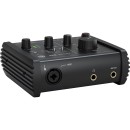
IK Multimedia AXE I/O One |
VS | |
|---|---|---|
| 1 Input / 3 Outputs at 192 kHz | Channels of I/O |
Analog: 2 Input / 5 Output |
| 192 kHz / 24-Bit | Maximum Sampling Rate | 192 kHz / 24-Bit |
| 1 | Number of Microphone Inputs | 2 |
| 1x Combo XLR-1/4" 3-Pin Balanced/Unbalanced Mic/Line/Hi-Z Input (Front Panel) 2x 1/4" TS Line Output 1x 1/4" TS Re-Amp Output (Front Panel) 1x 1/4" TRS Headphone Output |
Analog Audio I/O |
2x Combo XLR-1/4" TS Unbalanced Mic/Line Input 2x 1/4" TS Unbalanced Hi-Z Input 1x 1/4" TRS Headphone Output |
| Digital Audio I/O | ||
| 1x USB-C (on Interface) | Host Connection | 1x USB-B |
| Windows macOS |
OS Compatibility |
macOS 10.11 or Later Windows 8 or Later |
| USB Bus Power | Power Requirements | AC/DC Power Adapter (Included) |
